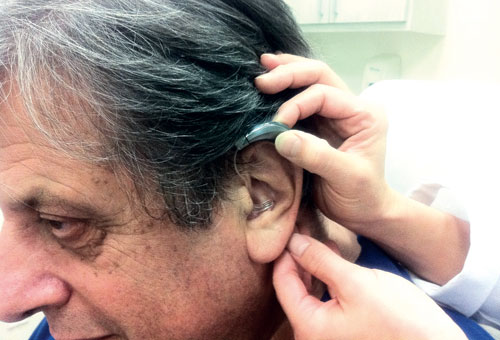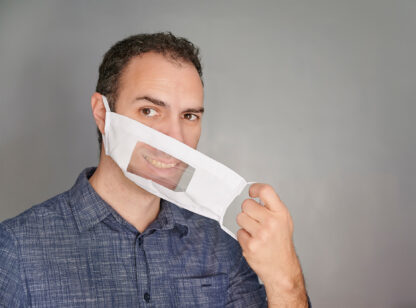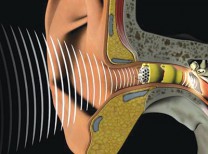Loss of hearing is America’s most prevalent physical ailment. More people suffer from hearing loss than from heart disease, cancer, blindness, tuberculosis, multiple sclerosis, venereal disease and kidney disease combined.
Despite the magnitude of the problem, we pay less attention to hearing loss than to any other major affliction. Perhaps it is because hearing loss is invisible and is physically painless. However, the inability to hear limits communication with others, and is socially isolating. For those who are profoundly hard of hearing or deaf, living in a world of silence can be emotionally devastating.
For individuals with severe hearing loss, who are not benefiting from hearing aids, a cochlear implant is an excellent option that can allow them to hear again and communicate with the world around them.
What is a Cochlear Implant?
A cochlear implant is a device designed to restore hearing in patients who have severe to profound sensorineural (inner ear and hearing nerve) hearing loss. It directly stimulates the cochlear nerve, by-passing the normal hearing mechanisms, and the damaged portion of the ear. It is indicated for patients with severe to profound hearing loss who can no longer hear well with hearing aids. A cochlear implant helps them to hear sounds at near normal loudness levels, experience greater clarity of speech, and some are even able to use the telephone.
How Does a Cochlear Implant Work?
Cochlear implants have external (outside) parts and internal (surgically implanted) parts that work together to allow the user to perceive sound.
External parts: The external parts include a microphone, a speech processor, and a transmitter. The microphone looks like a behind-the-ear hearing aid. It picks up sounds—just like a hearing aid microphone does—and sends them to the speech processor, which is typically housed with the microphone behind the ear. The speech processor is a computer that analyzes and digitizes the sound signals and sends them to a transmitter worn on the head just behind the ear. The transmitter sends the coded signals to an implanted receiver just under the skin.
Internal parts: The internal (implanted) parts include a receiver and electrodes. The receiver is just under the skin behind the ear. The receiver takes the coded electrical signals from the transmitter and delivers them to the array of electrodes that have been surgically inserted in the cochlea. The electrodes stimulate the fibers of the auditory nerve, and sound sensations are perceived.
Who Will Benefit from a Cochlear Implant?
Based on the newest guidelines for cochlear implantation approved by the Food and Drug Administration (FDA), individuals with the following typically receive benefit from a cochlear implant:
Adults:
- Severe to profound sensorineural hearing loss in both ears;
- Gain little or no benefit from appropriately-fit hearing aids following an adequate period of training;
- Have no medical or radiological contraindications;
- Have high motivation and appropriate expectations.
Children:
- 12 to 24 months of age and have profound sensorineural hearing loss in both ears;
- 24+ months of age with severe to profound sensorineural hearing loss in both ears;
- Receive little or no benefit from hearing aids following an adequate period of training;
- No medical or radiological contraindications;
- Have a network of family support that has a high degree of motivation and appropriate expectations for the child;
- Have an educational/rehabilitation program that emphasizes auditory skill development.
What is the Evaluation Process to Determine Candidacy?
During the comprehensive evaluation process, an audiologist with training in cochlear implants will first determine the patient’s hearing thresholds. The patient’s hearing aids are then evaluated to ensure they are appropriate for the degree of hearing loss. If the audiometric tests determine that the patient is a cochlear implant candidate, the otologist then conducts a thorough medical evaluation and discusses surgery with the patient. An MRI or CT scan is obtained, and other medical tests may be ordered to ensure there is no medical contraindication for cochlear implantation.
For children, educational, psychological, speech and language evaluations are recommended.
Implantation Process
Once the decision is made to proceed, the surgery is done. In adults, the surgery typically does not require an overnight stay in the hospital. About 4 weeks after surgery, the person is fitted with the external parts—the microphone and speech processor—and the implant is activated and programmed.
Additional visits are needed over the next several months for adjusting and programming the implant, as the individual develops skill in using the implant.
Outcomes
With proper patient selection, cochlear implantation can be a dramatic, life-changing event. Implant recipients can once again be a part of conversations with families and friends. They no longer feel isolated, alone and depressed. Hearing laughter, enjoying the voices of grandchildren, and rejoicing in the sound of music are some of the benefits individuals report. For the recipient and their families, a cochlear implant can significantly improve their quality of life.
Dr. Kato is the founder of The Ear Institute in Palm Desert. Her top priority is improving the quality of life of her patients. Dr. Kato can be reached at (760) 565.3900.
References are available upon request.












































Comments (0)